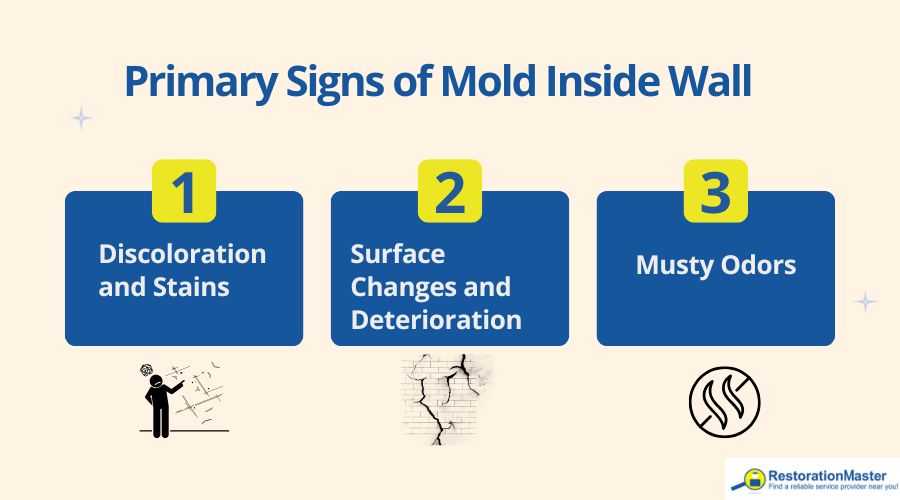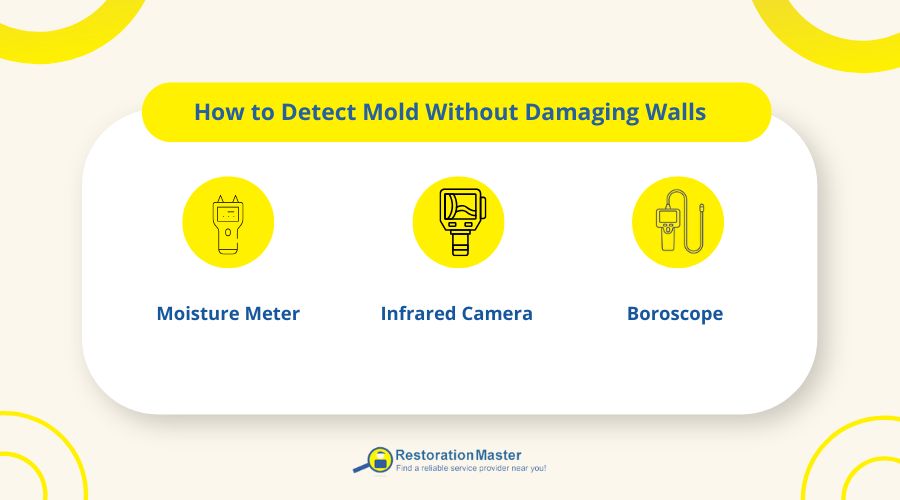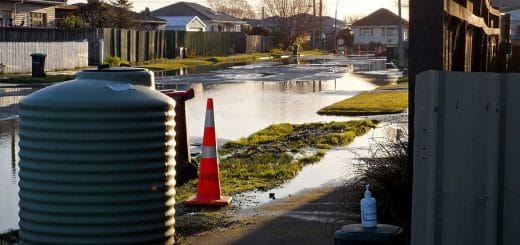How to Detect Mold Inside Walls
Have you ever walked past a wall and noticed a strange patch of discoloration or smelled a faint, musty odorAn odor is a smell, often detectable by the human nose, whic... More that doesn’t go away? Perhaps the paint on your walls seems to be bubbling for no reason at all. These small, unsettling signs may feel like minor annoyances, but they can actually be clues to a far more serious issue hiding within your home. MoldMold is a type of fungus that grows in damp or humid conditi... More can grow quietly behind walls, slowly damaging the structureStructure refers to the framework or components of a buildin... More of your house and affecting the air you and your family breathe.
MoldMold is a type of fungus that grows in damp or humid conditi... More is not always obvious. It can hide inside drywall, behind baseboards, or within insulationInsulation is a material used in buildings to reduce the tra... More, making it easy to overlook until it becomes a bigger problem. It thrives in damp, poorly ventilated areas, often appearing after water leaks, condensation, or even high humidityHumidity is the amount of moisture or water vapor present in... More in certain rooms. MoldMold is a type of fungus that grows in damp or humid conditi... More sporesSpores are microscopic reproductive units of fungi or mold t... More are more than just unsightly; they can irritate the eyes, nose, and throat, trigger allergic reactions, and worsen respiratory conditions like asthma.
Recognizing the early signs of hidden moldMold is a type of fungus that grows in damp or humid conditi... More is your first step toward protecting your home and your loved ones. By understanding what to look for and knowing how to investigate safely, you can address moldMold is a type of fungus that grows in damp or humid conditi... More before it spreads, safeguarding both your property and the health of everyone inside.
Why Mold Grows Inside Walls
MoldMold is a type of fungus that grows in damp or humid conditi... More does not appear out of nowhere. It needs moisture, a food source, and the right environment to thrive, and your walls can provide all three if conditions are right. Understanding these triggers can help you prevent moldMold is a type of fungus that grows in damp or humid conditi... More before it becomes a serious problem.
Water Leaks
Leaking pipes, roofs, or even window frames can let water seep into your walls unnoticed. Over time, this trapped moisture creates a perfect breeding ground for moldMold is a type of fungus that grows in damp or humid conditi... More. Even a slow drip can leadLead is a heavy metal that can be toxic to humans, especiall... More to growth behind drywall or wallpaper before you ever see it. For more guidance on spotting hidden leaks, you can read our guide on the 10 most common places to find water leaks in your home.
Condensation and Humidity
Areas with poor insulationInsulation is a material used in buildings to reduce the tra... More or significant temperature differences between inside and outside can collect condensation. Basements, bathrooms, and kitchens are especially vulnerable. High humidityHumidity is the amount of moisture or water vapor present in... More levels alone, without any leaks, can allow moldMold is a type of fungus that grows in damp or humid conditi... More sporesSpores are microscopic reproductive units of fungi or mold t... More to settle and grow.
Construction Materials
Drywall, wood, and insulationInsulation is a material used in buildings to reduce the tra... More provide surfaces that moldMold is a type of fungus that grows in damp or humid conditi... More can cling to and feed on. If these materials become damp, even temporarily, moldMold is a type of fungus that grows in damp or humid conditi... More can establish itself and spread quietly inside the walls.
Hidden Moisture Sources
Sometimes moisture comes from unexpected places. For example, a forgotten leak behind a refrigerator, a spill inside a wall cavity from an air conditioning unit, or dampness from nearby plumbing can all set the stage for moldMold is a type of fungus that grows in damp or humid conditi... More growth.
Key Signs That Mold May Be Hiding Inside Your Walls
Sometimes moldMold is a type of fungus that grows in damp or humid conditi... More doesn’t make itself obvious, but your home often gives gentle hints that something isn’t right. Paying attention to these subtle signals can help you catch moldMold is a type of fungus that grows in damp or humid conditi... More early, keeping your family safe and your home healthy.
Discoloration and Stains
Because mold growth is often a result of water damage, water stains can be an indicator of the presence of moldMold is a type of fungus that grows in damp or humid conditi... More. As such, if you spot water stains on your walls, then it is likely that there’s moldMold is a type of fungus that grows in damp or humid conditi... More growing behind them. Water stains can be yellow or brown in color, so look out for such colors on your wall. If the spots are damp, then that’s an obvious sign of moisture problems as well.
Another indicator of moldMold is a type of fungus that grows in damp or humid conditi... More growth is discoloration, which can occur even if you have repainted your home’s walls. Discoloration can also happen in the event that damage has been done from within. This is because the moldMold is a type of fungus that grows in damp or humid conditi... More will still be visible on the wall’s surface.
MoldMold is a type of fungus that grows in damp or humid conditi... More can appear in many shades, from black to white to brown to gray to green. If your wall has vinylVinyl is a durable synthetic plastic material commonly used ... More wallpaper, moldMold is a type of fungus that grows in damp or humid conditi... More will look pink, orange, or purple in appearance.
Surface Changes and Deterioration
Your walls’ appearance can change significantly if there’s moldMold is a type of fungus that grows in damp or humid conditi... More growth behind them. In addition to discoloration and stains, your walls may deteriorate. Paint or wallpaper can crack, peel, or bubble because of moisture and moldMold is a type of fungus that grows in damp or humid conditi... More growth. Furthermore, your walls may become warped or even bow or bulge when there’s a water issue, which often leads to moldMold is a type of fungus that grows in damp or humid conditi... More growth.
Guide: If you notice bubbling on your walls or ceilings, it’s often an early sign of water damage. Check out our guide on water bubbles on ceilings for steps to identify and address the problem early.
Odors
In the event that you are unable to visibly spot any signs of moldMold is a type of fungus that grows in damp or humid conditi... More growth, you’ll likely still be able to smell the moldMold is a type of fungus that grows in damp or humid conditi... More. MoldMold is a type of fungus that grows in damp or humid conditi... More gives off a musty odorAn odor is a smell, often detectable by the human nose, whic... More. It is similar to an earthy smell that you would find in a damp forest.
If you get down and smell the electrical outlets, then you will be able to more easily sniff out whether there is moldMold is a type of fungus that grows in damp or humid conditi... More growth behind your walls. It sounds like a silly thing to do, but outlets have good access to the space behind the walls in your home.

Tools and Techniques to Detect Mold Without Damaging Walls
To detect moldMold is a type of fungus that grows in damp or humid conditi... More inside walls without causing damage, you can use several tools and techniques:
Professional Tools and Techniques
Moisture Meters
These devices measure the amount of moisture trapped in your walls. Persistent high readings can indicate the perfect conditions for moldMold is a type of fungus that grows in damp or humid conditi... More to develop, even if nothing is visible on the surface.
Infrared Cameras
Temperature variations in your walls can reveal hidden damp spots. Infrared cameras help experts see where moisture has collected, which may be fueling moldMold is a type of fungus that grows in damp or humid conditi... More growth out of sight. Read our guide how to detect water damage with infrared camera.
Borescopes
A borescope is a small, flexible camera that can peek inside your walls through tiny openings. This allows for a clear view of hidden spaces without needing to cut out large sections of drywall.

Simple Methods You Can Try
| Method | How to Use It | What It Tells You |
|---|---|---|
| Close Visual InspectionA visual inspection is the initial examination of a property... More | Examine walls carefully for discoloration, soft spots, or warpingWarping is the bending, twisting, or distortion of materials... More | Early signs of moldMold is a type of fungus that grows in damp or humid conditi... More growth or moisture damage |
| Smell Test | Check corners, baseboards, and behind furniture for musty or earthy odors | Indicates hidden moldMold is a type of fungus that grows in damp or humid conditi... More even if it’s not visible |
| Tap Test | Gently tap on wall surfaces | Hollow or spongy sounds suggest moisture behind the wall |
| Small InspectionInspection is the careful examination and assessment of a pr... More Hole | Make a tiny, careful hole to inspect inside | Reveals hidden moldMold is a type of fungus that grows in damp or humid conditi... More; requires proper tools and protective gear |
How to Detect Mold Inside Walls – Video












